Λήμνος: Τα Top 10 αξιοθέατα που δεν πρέπει να παραλείψεις

Η Λήμνος, το “ανεξερεύνητο” νησί του Αιγαίου προσφέρεται για μοναδικές διακοπές. Τα τελευταία χρόνια το νησί γνωρίζει όλο και περισσότερη άνθηση αφού τις ομορφιές του ανακαλύπτουν ολοένα και περισσότεροι Έλληνες και ξένοι επισκέπτες. Και όχι άδικα αφού η Λήμνος είναι ένας τόπος ευλογημένος που συνδυάζει απίστευτα τοπία, κρυστάλλινα πεντακάθαρα νερά, μοναδικά αξιοθέατα αλλά και ποιοτικό φαγητό. Είτε λοιπόν έχεις στη διάθεση σου λίγες μέρες είτε και περισσότερες το μόνο σίγουρο είναι ότι δεν θα τη χορταίνεις.
Σε αυτό το άρθρο συγκέντρωσα τα top locations που πρέπει οπωσδήποτε να επισκεφτείς όταν πάς στο νησί και είμαι σίγουρη ότι θα σε μαγέψουν όπως μάγεψαν και εμένα.
1. Αμμοθίνες – Αμμόλοφοι
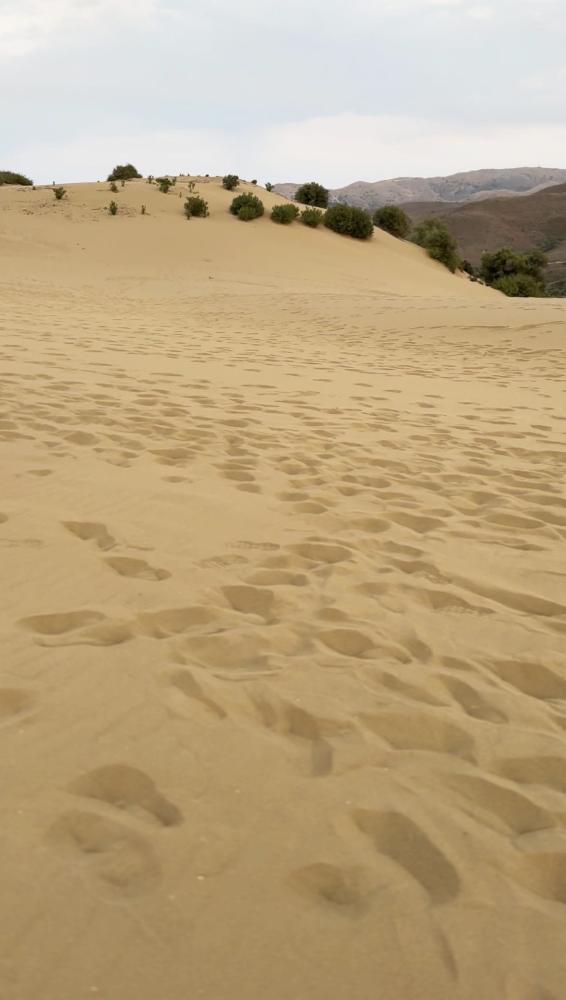
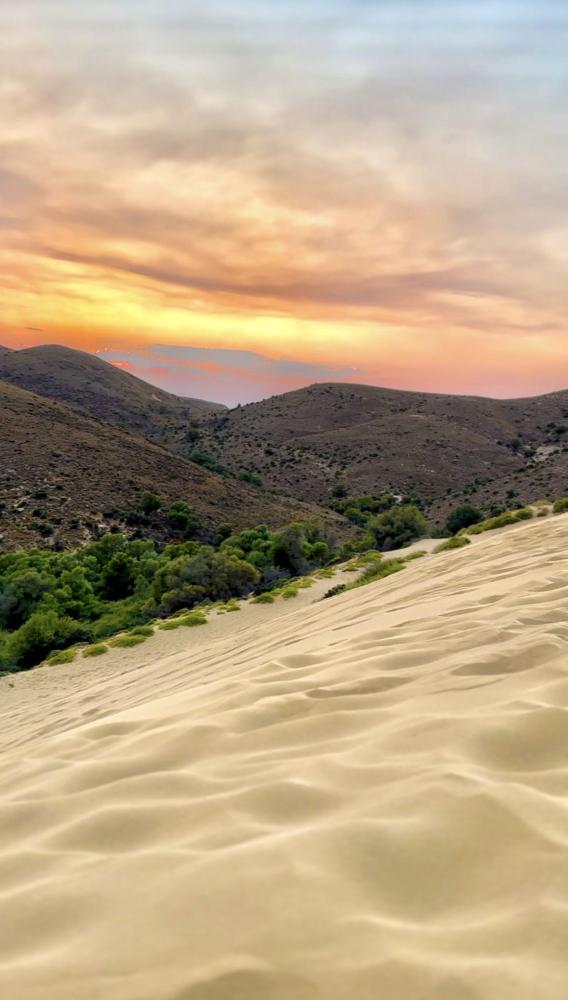
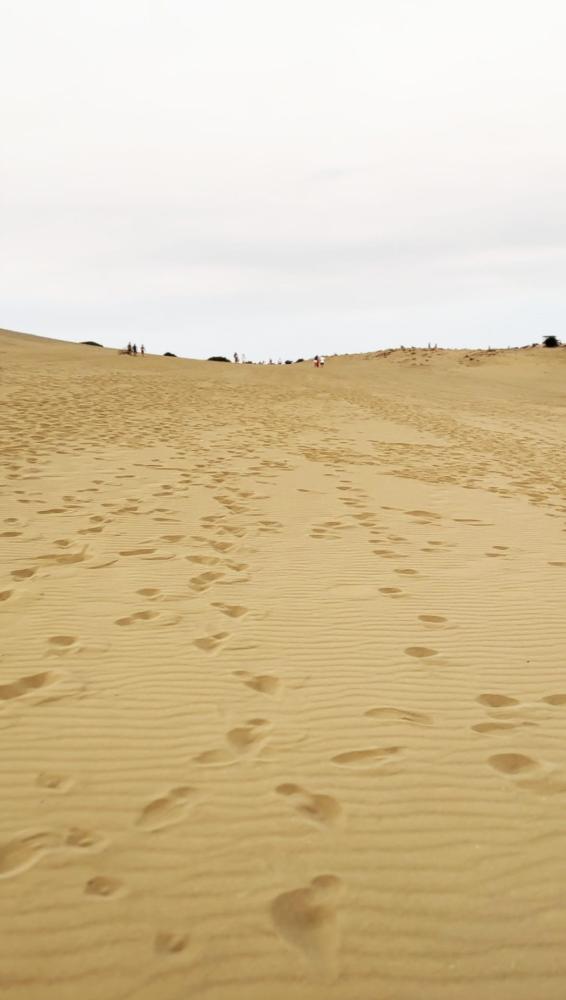
Οι αμμοθίνες , οι οποίες από πολλούς αποκαλούνται ως η μοναδική έρημος της Ευρώπης είναι πραγματικά ένα ιδιαίτερο φυσικό τοπίο που θυμίζει Σαχάρα και αξίζει να επισκεφθεί κανείς χωρίς δεύτερη σκέψη.
Υπεύθυνη για αυτό το φαινόμενο είναι η φύση και μόνο αφού όπως υποστηρίζεται δημιουργήθηκαν από την παράλληλη δράση της θάλασσας κα των ανέμων οι οποίοι μετακίνησαν την άμμο και δημιούργησαν τους αμμόλοφους.
Με έκταση περίπου 70 στρέμματα οι αμμοθίνες είναι ένα συγκλονιστικό τοπίο στο οποίο μπορείς να περπατήσεις, να κατρακυλήσεις από τους λόφους και, αν είσαι από τους τολμηρούς να κάνεις “snowboard” με σανίδα στην άμμο!
Για τους απλούς εξερευνητές αξίζει να πω πως ιδανικές ώρες για να επισκεφτεί κανείς τις αμμοθίνες είναι είτε νωρίς το πρωί όπου δεν θα έχει προλάβει ο ήλιος να κάψει την άμμο είτε το απογευματάκι, πριν δύσει ο ήλιος ώστε να μπορέσετε να περπατήσετε ξυπόλητοι αλλά και για να προλάβετε το μαγευτικό ηλιοβασίλεμα.
2. Φαρακλό – Γεωλογικοί Σχηματισμοί


Η Λήμνος είναι ένα νησί με πλούσια γεωλογική ιστορία, αφού το ηφαιστειογενές της έδαφος της χαρίζει μια σπάνια γεωλογική ποικιλομορφία. Ωστόσο, το μεγαλύτερο μέρος από αυτούς τους γεωλογικούς σχηματισμούς βρίσκεται συγκεντρωμένο στο Γεωλογικό Πάρκο του Φαρακλού στο βόρειο κομμάτι του νησιού μετά το χωριό Προπούλι.
Οι γεωλογικοί σχηματισμού λέγεται πως δημιουργήθηκαν πριν από χιλιάδες χρόνια όταν η λαβα από το ανενεργό για χρόνια ηφαίστειο του νησιού ήρθε σε επαφή με το νερό. Τα ιδιαίτερα αυτά πετρώματα έχουν πορτοκαλοκίτρινο χρώμα και είναι σαν γλυπτά. Συνήθως έχουν στρογγυλό σχήμα γι’ αυτό και οι ντόπιοι τα αποκαλούν «φραγκοκέφαλα».
Πρόκειται για ένα εντυπωσιακό αξιοθέατο, έργο τέχνης και ένα από τα δικά μου αγαπημένα σποτ του νησιού, που η ίδια η φύση δημιούργησε και για άλλη μια φορά χάρισε απλόχερα στο νησί.
3. Αλυκή
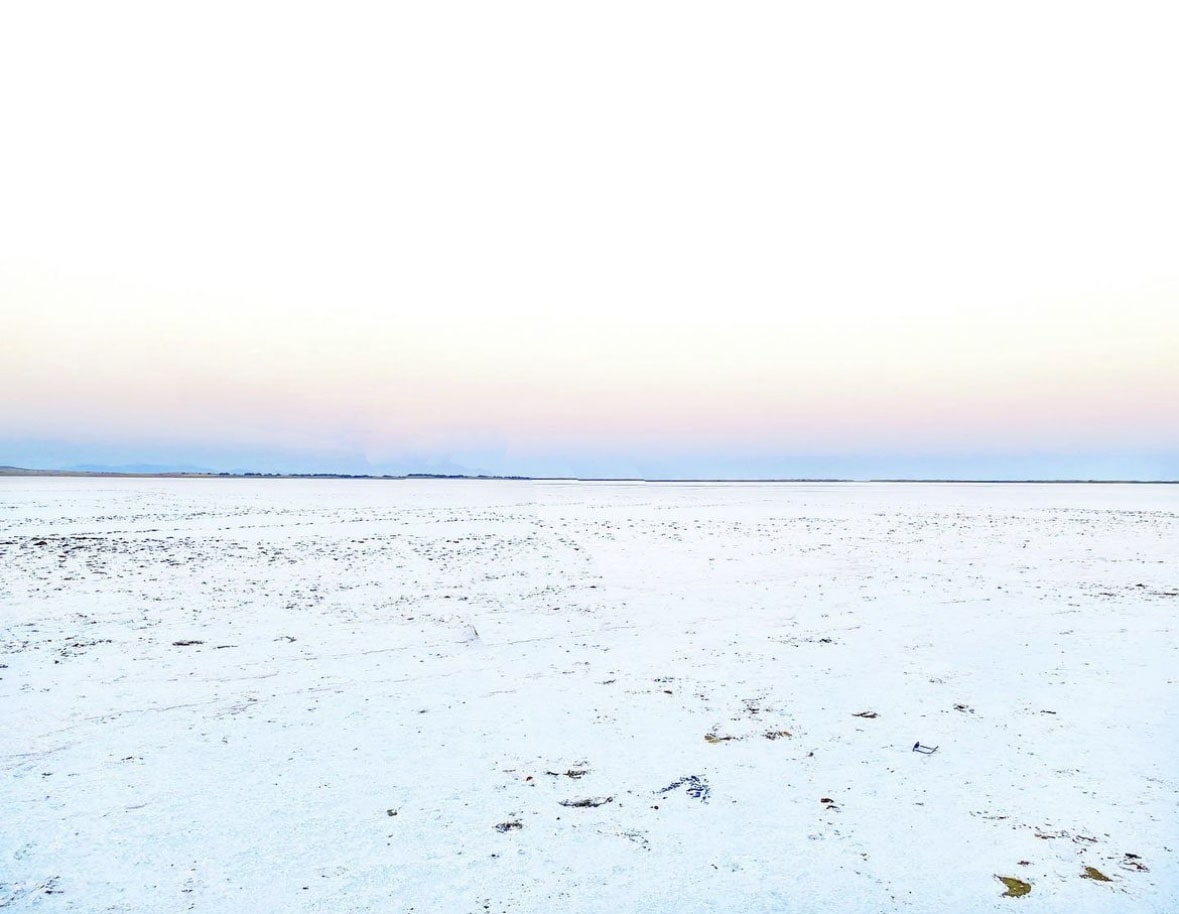

Η Αλυκή αποτελεί ένα ακόμα σπάνιο δημιούργημα της φύσης. Πρόκειται για μια λιμνοθάλασσα με αλμυρό νερό, έκτασης περίπου 6.300 στεμμάτων, κοντά στο χωριό Κοντοπούλι. Η λίμνη επικοινωνεί με τη θάλασσα μέσω μιας αρκετά στενής διώρυγας γι’ αυτό και είναι σχετικά ρηχή.
Το καλοκαίρι η λίμνη ξεραίνεται με αποτέλεσμα να παραμένει στον πάτο όλο το αλάτι και να δημιουργεί ένα εντυπωσιακό ολόλευκο τοπίο που μοιάζει σαν χιόνι.
Για αρκετά χρόνια η αλυκή αποτελούσε την κύρια πηγή αλατιού για τους κατοίκους του νησιού. Άλλωστε πολλές είναι οι οικογένειες που ακόμη και σήμερα εξασφαλίζουν το αλάτι για το σπίτι τους μαζεύοντάς το από εκεί.
Στην Αλυκή μπορείς να περπατήσετε πάνω στο ολόλευκο στρώμα αλατιού, να βγάλεις τις φωτογραφίες σου ακόμα και να μαζέψεις το δικό σου αλάτι. Στην περιοχή μπορεί κανείς επίσης να παρατηρήσει εκατοντάδες είδη πουλιών που την χρησιμοποιούν ως στάση για το μεγάλο ταξίδι της μετανάστευσης, ενώ στην Αλυκή Λήμνου έχει παρατηρηθεί ένα από τα μεγαλύτερα σμήνη ροζ φλαμίνγκο στην Ελλάδα με πληθυσμό περίπου 5.000!
4. Το Κάστρο της Μύρινας
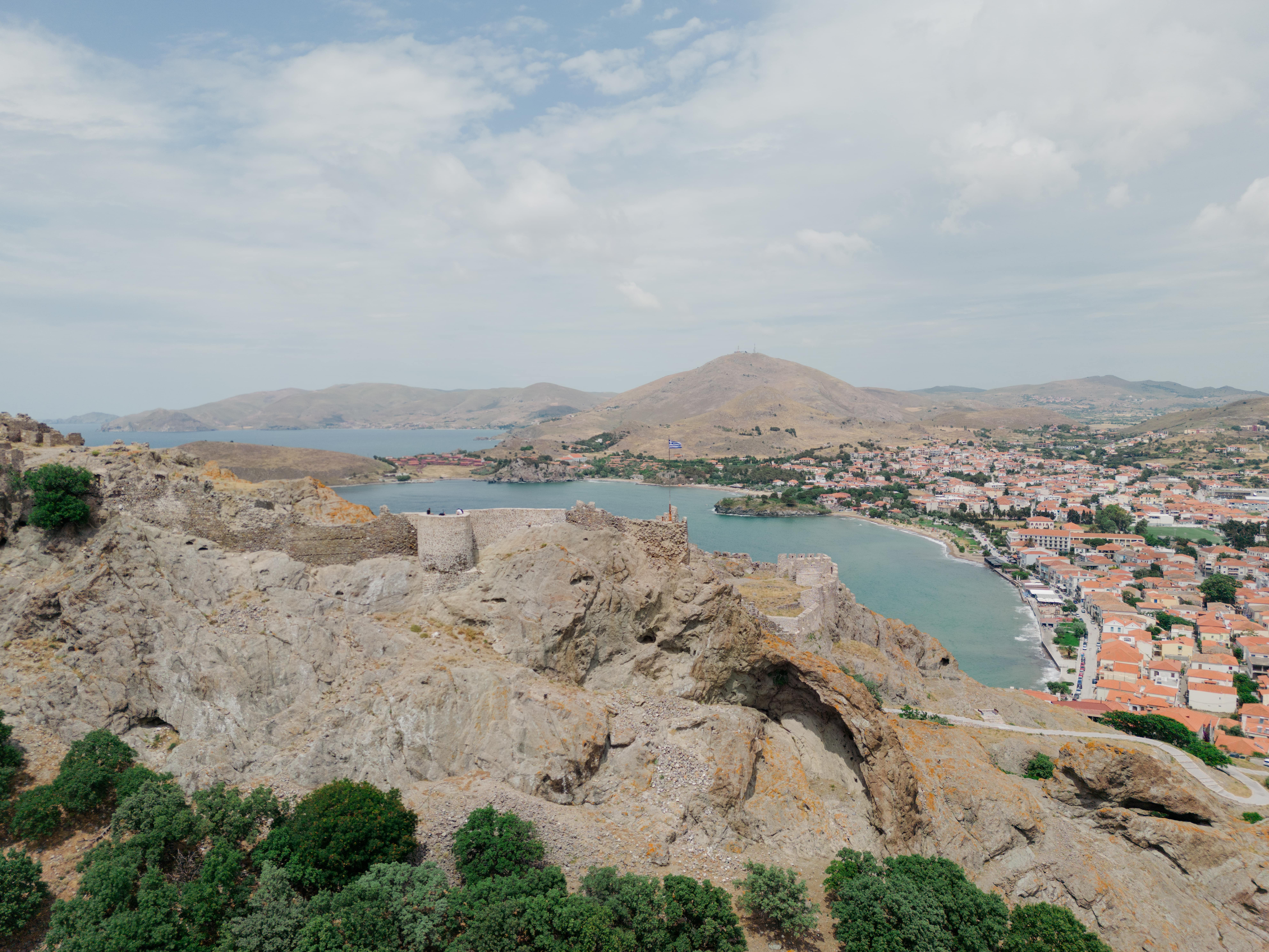

Στη Μύρινα την αρχόντισσα της Λήμνου και πρωτεύουσα του νησιού βρίσκεται το εμβληματικό Κάστρο. Το Κάστρο της Μύρινας είναι το μεγαλύτερο κάστρο του Αιγαίου με έκτασή που καλύπτει 144 στρέμματα γης και ύψος συνολικά περίπου 120 μέτρα.
Η τοποθεσία του Κάστρου είναι σε στρατηγικό σημείο αφού εποπτεύει δύο όρμους και το εξαιρετικό φυσικό λιμάνι της Μύρινας. Η θέση του είχε σκοπό να θωρακίσει το νησί από όλες τις πλευρές και να το προστατέψει από τις απειλές από τη θάλασσα.
Σήμερα το κάστρο είναι επισκέψιμο και αποτελεί ένα από τα σημαντικότερα αξιοθέατα του νησιού. Προσφέρει μια όμορφη περιπατητική διαδρομή όπου μπορείς να συναντήσεις ελάφια και αγριοκάτσικα. Φτάνοντας στην κορυφή η θέα θα σε ανταμείψει με τον καλύτερο δυνατό τρόπο.
5. Παναγία Κακαβιώτισσα
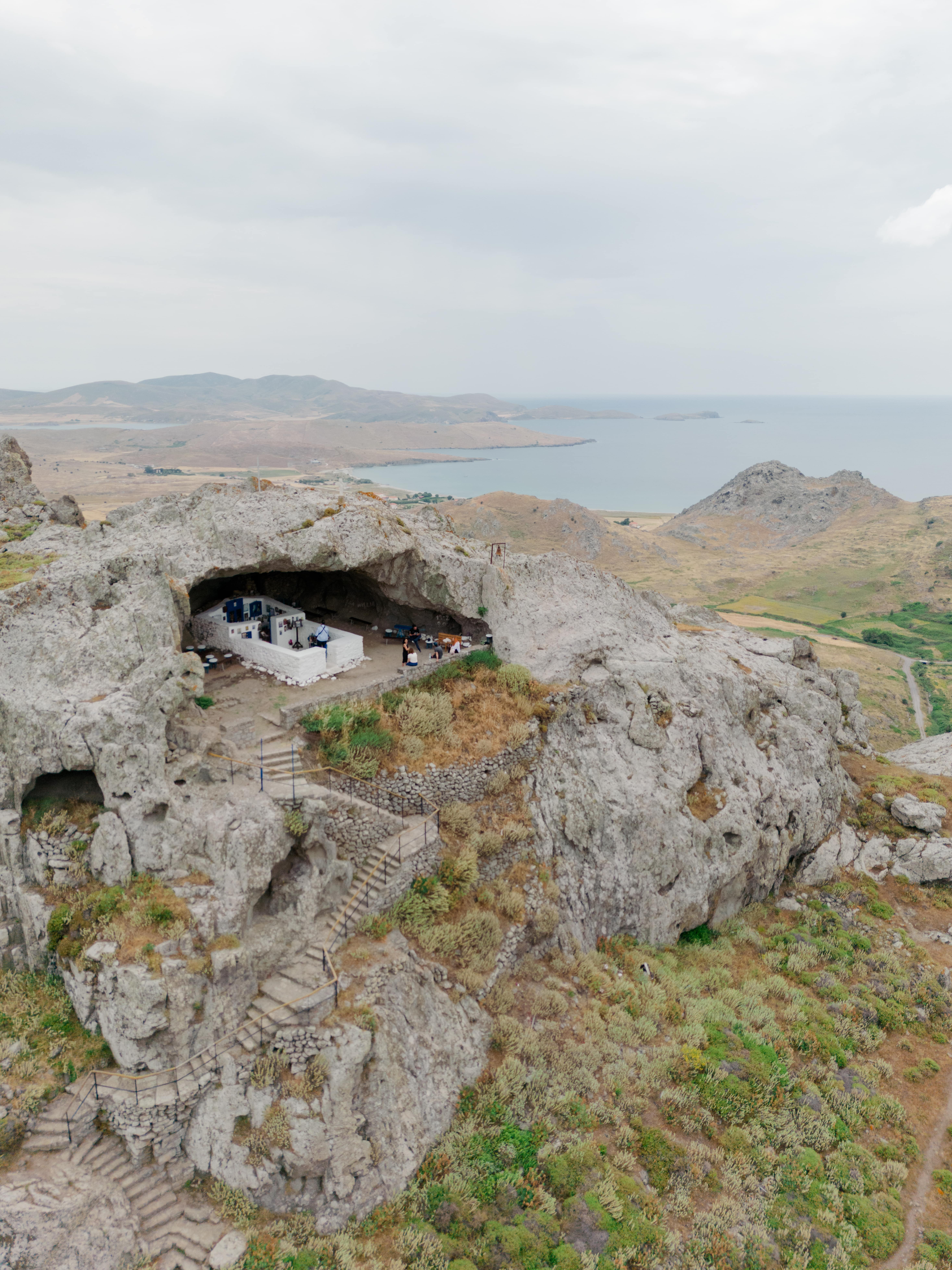

Το γραφικό εκκλησάκι της Παναγιάς Κακαβιώτισσας είναι χτισμένο στην κορυφή του βουνού Κάκαβος (εξού και το όνομα) μέσα σε μια σπηλιά. Αποτελεί τη μοναδική εκκλησία στο κόσμο χωρίς σκεπή και υπολογίζεται ότι χτίστηκε εκεί το 1.300 από ερημίτες μοναχούς.
Γύρω στο 1830, ο τελευταίος μοναχός που είχε απομείνει αποφάσισε να εγκαταλείψει το βουνό και το εκκλησάκι της Παναγιάς Κακαβιώτισσας για να πάει στο Άγιο Όρος. Σύμφωνα με τον θρύλο, μια μέρα μπήκε στη θάλασσα και το ράσο του έγινε βάρκα που τον οδήγησε εκεί. Όμως, πριν φύγει ο μοναχός ζήτησε από έναν βοσκό να πάει και να πάρει την εικόνα από το εκκλησάκι και κάθε Λαμπροτρίτη να την ξαναπηγαίνει εκεί για να τη λειτουργούν. Από τότε η εικόνα της Παναγιάς Κακαβιώτισσας είναι στην κατοχή μιας οικογένειας από το διπλανό χωριό (τον Κοντιά) η οποία περνάει από γενιά σε γενιά κάτι σαν παράδοση.
Για να προσεγγίσει κανείς το εκκλησάκι χρειάζεται να περπατήσει ένα βατό μονοπάτι περίπου 20-30 λεπτών. Αν και έχει λίγο περπάτημα το τοπίο πραγματικά σε μαγεύει αφού το εκκλησάκι βρίσκεσαι ανάμεσα στα επιβλητικά βράχια του βουνού Κάκαβου.
6. Ηφαιστία – Αρχαίο θέατρο της Ηφαιστίας
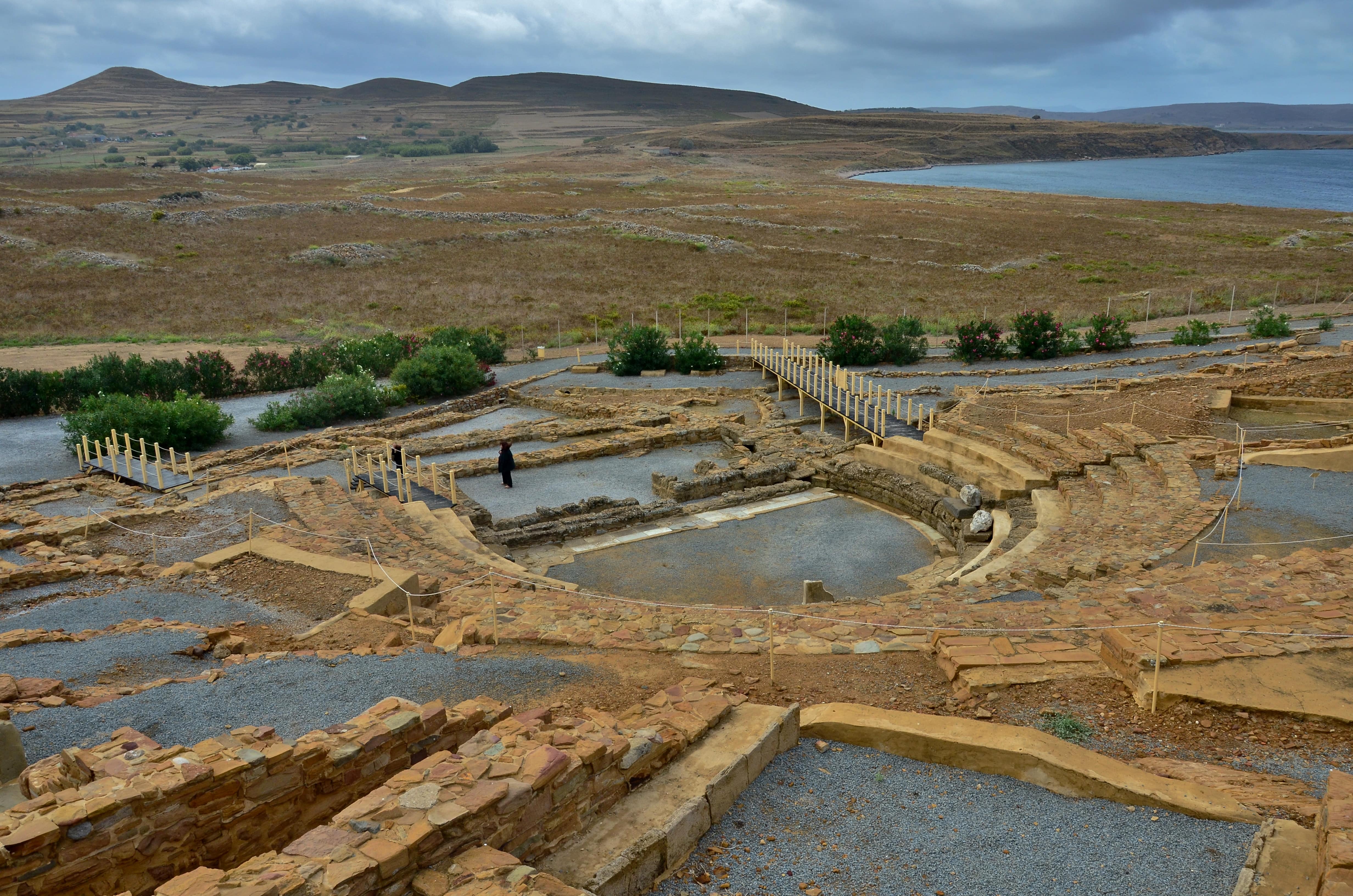

Η Ηφαιστία ήταν ή αρχαιότερη και η μεγαλύτερη πόλη της Λήμνου. Αποτελούσε την έδρα της αρχαιοελληνικής θρησκείας στο νησί και προστάτης της ήταν ο θεός Ήφαιστος, στον οποίο οφείλει και το όνομά της.
Αυτό όμως που κάνει την Ηφαιστία να ξεχωρίζει είναι το αρχαίο θέατρο της ελληνιστικής περιόδου, το οποίο κατατάσσεται μεταξύ των αρχαιότερων του ελληνικού κόσμου. Σήμερα, το αρχαίο θέατρο της Ηφαιστίας, που βρίσκεται στην καρδιά του αρχαιολογικού χώρου, έχει αναστηλωθεί και τα τελευταία χρόνια είναι επισκέψιμο και μάλιστα φιλοξενεί θεατρικά φεστιβάλ, συναυλίες και παραστάσεις.
Η Ηφαιστία βρίσκεται κοντά στο χωριό Κοντοπούλι, απένταντι από το ιερό των Καβείρων και για να φτάσει κανείς εκεί θα πρέπει να διανύσει έναν ομαλό χωματόδρομο.
7. Καβείρια - Ιερός Ναός των Καβείρων


Οι Κάβειροι ήταν θεότητες αρχαίας Ελληνικής μυστηριακής λατρείας, η οποία πρωτοεμφανίζεται στη Λήμνο, τη Σαμοθράκη και τη Θήβα. Σχετικά με τους Κάβειρους της Λήμνου, αναφέρεται ότι ο Ήφαιστος και η θεά Καβειρώ έκαναν τον Κάδμιλο, ο οποίος γέννησε τους τρεις Κάβειρους. Το σύμβολο των τριών Λήμνιων Καβείρων ήταν η λαβίδα και το σφυρί του μεταλλουργού.
Οι Κάβειροι θεωρούνταν κακοποιά πνεύματα, κακοί δαίμονες, που από τα βάθη της γης και από το βυθό της θάλασσας εξαπέλυαν φωτιά και τράνταζαν τη γη. Σε αυτούς αποδίδονταν οι σεισμοί και οι πυρκαγιές. Ήταν κοντοί στο ύψος και ήταν υπερφυσικά πνεύματα που εκπροσωπούσαν την υπόγεια φωτιά και τις μεταλλευτικές εργασίες.
Προς τιμή τους, στο Ιερό των Καβείρων, τελούνταν απόκρυφες θρησκευτικές τελετές μύησης, γνωστές ως Καβείρια Μυστήρια. Οι τελετές γίνονταν βράδυ, μια φορά το χρόνο και διαρκούσαν εννέα ημέρες.
8. Σπηλιά του Φιλοκτήτη
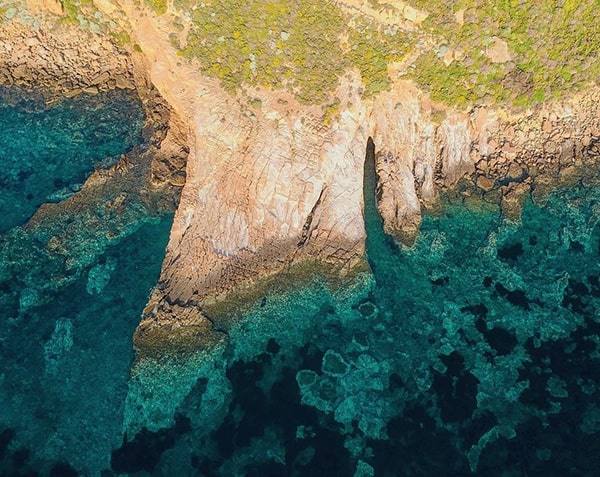

Η σπηλιά του Φιλοκτήτη είναι ένα ακόμη μοναδικό αξιοθέατο που μπορείς να επισκεφτείς στις διακοπές σου στη Λήμνο. Η σπηλιά είναι προσβάσιμη μόνο από τον ιερό Ναό των Καβείρων όπου και υπάρχει μονοπάτι με σκαλιά που οδηγούν σε αυτήν. Η Είσοδος στη σπηλιά μπορεί να γίνει με δύο τρόπους είτε από μια μικρή σχισμή τρυπώνοντας στο βράχο, είτε από τη θάλασσα, κολυμπώντας στα καταγάλανα νερά.
Η Σπηλιά πήρε το όνομά της από τον Φιλοκτήτη ο οποίος σύμφωνα με την μυθολογία εγκαταλείφθηκε εκεί από τους συμπολίτες του σε μια στάση τους καθώς πήγαιναν στην Τροία να πολεμήσουν στον Τρωικό πόλεμο. Εκεί, ένα δηλητηριώδες φίδι τσίμπησε τον Φιλοκτήτη, προκαλώντας του αφόρητους πόνους και τραύμα με ανυπόφορη δυσοσμία που διήρκεσε για πολλές μέρες οπότε οι Έλληνες αποφάσισαν να τον εγκαταλείψουν εκεί. Ο Φιλοκτήτης κατάφερε να γιατρευτεί με τη βοήθεια της Λημνίας Γης και να επιβιώσει για 10 ολόκληρα χρόνια μέχρι που τελικά μέσω ενός χρησμού του δόθηκε η ευκαιρία να σμίξει ξανά με τους άντρες του, καθώς όντας κάτοχος του τόξου και των δηλητηριωδών βελών του Ηρακλή, κλήθηκε να βοηθήσει στη μάχη για την πτώση της Τροίας βάζοντας έτσι τέλος στο δεκαετή πόλεμο.
9. Πολιόχνη


Η Πολιόχνη αποτελεί ένα αρχαιολογικό διαμάντι το οποίο, αν είσαι λάτρης της αρχαιολογίας αξίζει πραγματικά να θαυμάσεις. Είναι ένας από τους σπουδαιότερους αρχαιολογικούς χώρους, όχι μόνο της Λήμνου, αλλά και ολόκληρου του Ελλαδικού χώρου. Θεωρείται ως η αρχαιότερη ευρωπαϊκή πόλη και το πρώτο εμπορικό λιμάνι της Ευρώπης.
Χτίστηκε στις αρχές της νεολιθικής περιόδου την 4η ή 5η χιλιετία π.Χ., στην ανατολική πλευρά του νησιού, ακριβώς απέναντι από την Τροία. Αξίζει να σημειωθεί πως ανάμεσα στα ευρήματα υπάρχει πλήθος κατοικιών, ένα μέγαρο, αλλά και το Βουλευτήριο, ένα από τα παλαιότερα στοιχεία δημοκρατικής λειτουργίας του αρχαίου κόσμου.
Επιπρόσθετα, στην Πολιόχνη, βρέθηκε κι ένας θησαυρός από χρυσά κοσμήματα, που αποτελεί ένα εξαίσιο δείγμα εξελιγμένης χρυσοχοΐας αλλά και συσσώρευσης δύναμης και πλούτου στο νησί.
10. Άγιος Νικόλαος
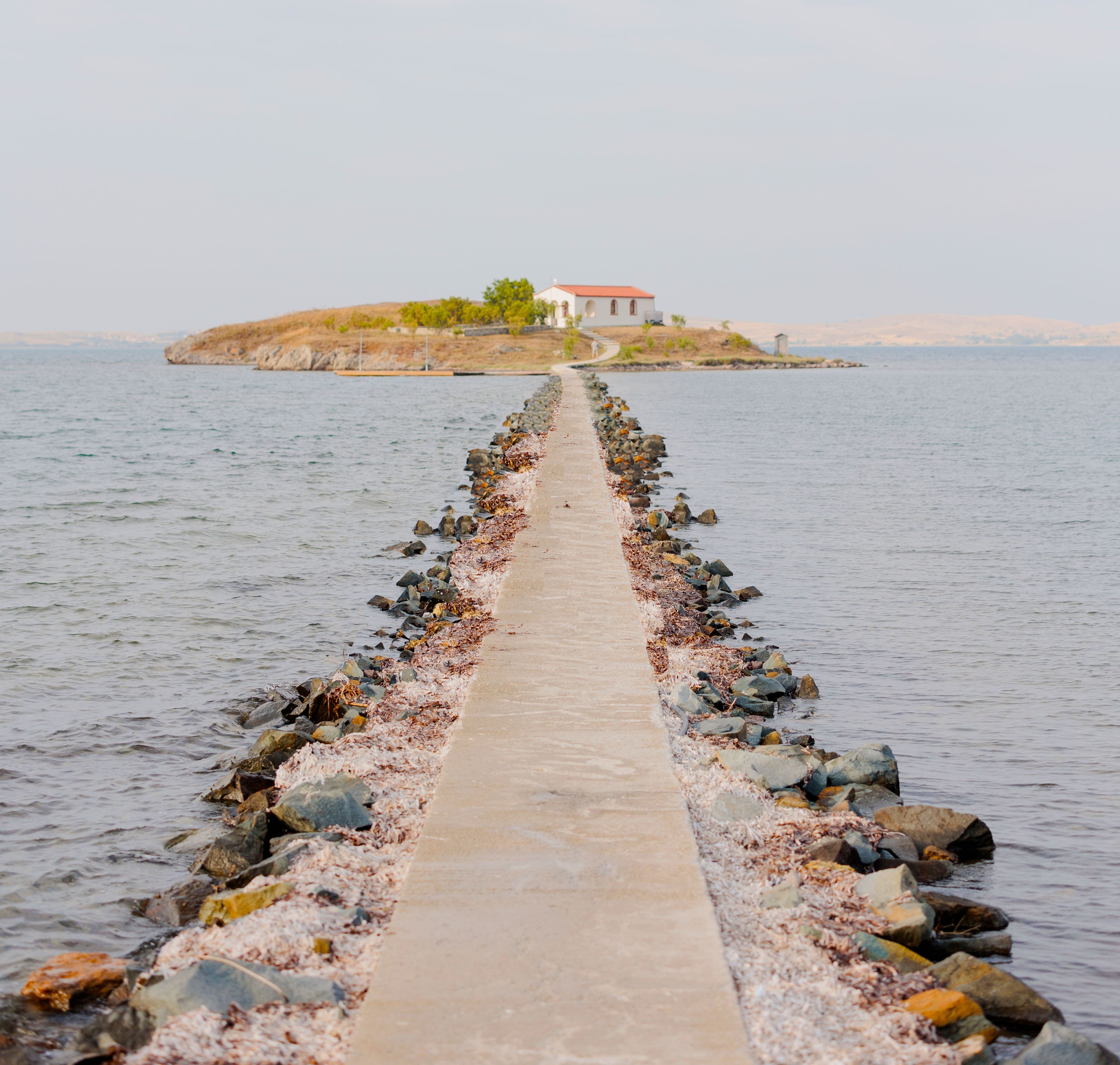

Κοντά στο χωριό της Νέας Κούταλης, πίσω στον κάμπο του χωριού κι ανάμεσα από τα σπαρμένα σιταροχώραφα ξεπροβάλει ένα μικρό νησάκι με το ξωκλήσι του.
Το νησάκι συνδέεται με τη στεριά, με ένα στενό προσβάσιμο μονοπατάκι το οποίο μπορείς φυσικά να διασχίσεις και να σε οδηγήσει κατευθείαν στο εκκλησάκι. Είναι μια πολύ όμορφη εμπειρία καθώς η διαδρομή μοιάζει σαν να περπατάς πάνω στη θάλασσα και αξίζει να το επισκεφτείς.
Εσύ ακόμα να τα ανακαλύψεις;
